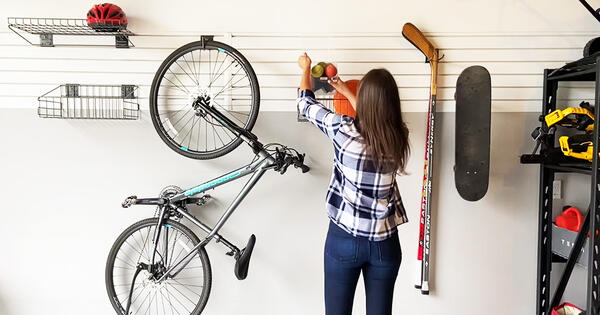This post was originally published in January 2023. Last updated: November 2023.
A finished basement adds living space to your home, increases your home's value, and even offers energy savings. But how much does it cost to finish a basement in 2024? And what factors will influence pricing? Whether you choose the do-it-yourself approach or hire professionals, we’ll help you navigate the budgeting process to finish your basement.
Why Should I Finish My Basement?
If you’re on the fence about whether or not you should finish your basement, you shouldn’t be. There are several benefits to finishing a basement:
A finished basement adds extra living space to your home
Finishing your basement increases the usable square footage of your home. Whether you need a space for entertainment, relaxation, work, or hobbies, a finished basement creates additional space and the flexibility to accommodate all these activities and more.
A finished basement can increase your home’s value
If you plan to sell your home in the future, a finished basement can significantly increase its overall value and make it more attractive to potential buyers. It can also help your home stand out against others in the market.
A finished basement can help improve your overall home organization
While your unfinished basement may be a dumping ground for boxes, bins, and items that don’t quite fit anywhere else in your home, finishing your basement can help you create additional and well-organized storage space. Whether you opt for closets, cabinets, built-in shelves, or an on-the-wall storage system like Trusscore SlatWall, you can organize your belongings, make it easier to find things when you need them, and reduce the clutter in the rest of your home.
A finished basement can boost your home’s energy efficiency
Insulating and finishing your basement can help regulate temperatures and reduce your home’s overall heating and cooling costs, leading to energy savings.
A finished basement can reduce the noise in your home
A finished basement can also help you reduce noise transmission between floors, which is especially beneficial if you have a noisy HVAC system, laundry machines, or a surround sound system downstairs.
The Average Cost to Finish a Basement in 2024
An unfinished basement has none of the elements that make it livable, which means you have to start from scratch. This includes installing framing, plumbing, insulation, ventilation, flooring, and wall coverings.
The cost of finishing basement depends on the size of your space, the materials you choose to build with, and the cost of labor in your area (if you don't plan to DIY any parts of the project). In the U.S., finishing a basement typically costs between $4,000 to $34,500, with the national average being around $20,000.
If you’re planning a basement renovation or remodel (learn the difference between a renovation and a remodel here!), your costs will look significantly different. The cost of a basement renovation will depend on the scope of the changes and can range from $1,000 to $20,000. For a basement remodel that changes the layout or structure of your basement, you can expect to pay between $4,000 and $45,000, or $20,000 on average. Since a renovation or remodel happens after a basement is finished, the costs are incurred on top of your initial finishing project.

What Are the Factors Influencing Basement Finishing Cost?
There are several factors that will influence the price of your project. Here’s a helpful cost breakdown for finishing a basement to set your expectations:
Framing
If your basement is in its most basic state — with just concrete walls and floor — you’ll have to frame out the walls and ceiling before you can officially start your project. Wood framing costs $1 to $5 per square foot in material (depending on local lumber prices) and an additional $4 to $8 per square foot in labor. Costs increase if your walls are taller than 8’ and if you have a lot of windows and doors to accommodate. Insulation.
Insulation
helps your basement stay warm in the winter, during the summer, insulation acts as a barrier against hot outdoor air to keep your basement cool. You can choose between spray foam, batting, and blow-in insulation, and you can expect to pay between $0.50 to $2 per square foot for the materials and an extra $1 to $1.50 in labor costs.
Wall and Ceiling Covering
Many homeowners opt to finish their basements with drywall to match the rest of their house. Drywall costs $1.50 to $3.50 per foot, including materials and installation labor, and costs can increase depending on room size, ceiling height, drywall type, and drywall texture. If your basement is a flood risk or is prone to water damage, water resistant wall and ceiling panels like
Trusscore Wall&CeilingBoard are a great alternative to drywall. For an 18 x 24 basement, you can expect to pay around $3,500, and you can easily install the product yourself to save on labor costs.
Paint
If you cover your basement walls with drywall, you’ll have to factor in paint to your total costs. On average, DIY painting costs between $1 and $3 per square foot, while professional painting costs between $2 and $6.
Flooring
When it’s time to select a floor covering for your basement, pricing will vary depending on the material you choose: Laminate flooring costs $1 to $6 per square foot, carpet costs $2 to $8, ceramic tile costs $7 to $14, and hardwood costs $6 to $13.
Electrical Wiring
You should only factor in electrical wiring costs if you plan to create new rooms in your basement as part of your project. New wiring costs $3 to $5 per square foot on average while rewiring costs between $6 to $10 per square foot.
Plumbing
Like with electrical wiring, plumbing costs are often only incurred when creating new rooms in your basement, like a bathroom or laundry room, for example. Plumbing costs around $6 per square foot.
Light Fixtures
Since most basements have limited windows and doors to provide natural light, light fixtures are a must when finishing your space. Installing new light fixtures can cost anywhere from $75 to $500 per fixture.
There are other basement renovation expenses you can expect to incur, too: If you’re changing your basement’s structure, electrical wiring, or plumbing, you’ll need a permit from your local municipality. Permits cost between $150 to $1,500, on average. And after your walls and ceilings are taken care of, you should also factor in furniture costs, especially if you’re starting from scratch. The collective cost of furniture, rugs, artwork, and accessories or décor can range anywhere from $2,500 to $20,000 or more depending on your decorating vision.
* All prices listed in this post are in USD and represent a national average. Actual pricing may vary depending on your region and the materials you choose to build with. Last updated: November 2023
Start Planning Your Trusscore Project
Use the Trusscore Cost & Materials Estimator to explore different design options for your interior space.
DIY vs Professional Install for Finishing a Basement
It’s no surprise that professional basement finishing costs more than doing it yourself — you must pay for not only the materials, but also for the labor, which quickly adds up depending on the skill level and speed of the person you hire.
An unfinished basement is an eyesore for prospective home buyers, and the projected cost of finishing it will negatively affect how much they’ll offer you for your home.
If you’re planning to DIY this reno, follow our step-by-step guide and start by breaking the project down into three separate categories — walls, ceiling, and flooring — and tackling each category one at a time. This approach can help you keep costs low and make the project more manageable for you as a DIYer.
If you include Trusscore Wall&CeilingBoard in your design, your project is even more DIY-friendly: Our pre-finished panels install four times faster than drywall with no special tools or skills required. You’ll even avoid time-consuming steps like mudding, taping, priming, and painting. Plus, once they’re installed, they’re built to last. The panels are scratch, dent, and damage resistant, and they’re 100% moisture and water resistant. And unlike drywall, the panels can be routinely cleaned with soap and water, ensuring your finished basement always looks its best.






